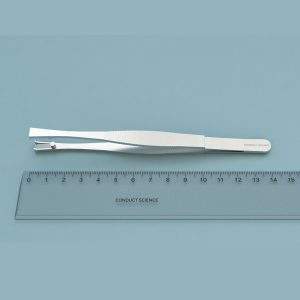$3,890.00 – $4,990.00Price range: $3,890.00 through $4,990.00
The Visual X Maze, also known as the Visual-Stimuli 4-arm Maze (ViS4M), is designed to quantitatively evaluate visual and cognitive functions in rodents. This apparatus is particularly useful for studying conditions such as early cognitive decline related to aging and Alzheimer’s disease (Vit et al., 2021, Vit et al., 2020). The maze features an X-shaped layout and can be equipped with light-emitting diodes (LEDs) to investigate color vision or various colored objects to assess contrast vision in rodents.
The ViS4M consists of black acrylic walls mounted on a glass or acrylic base. Each arm of the maze measures 45 cm in length, 10 cm in width, and 15 cm in height. The bottom of each arm is fitted with transparent and semi-transparent white floor plates secured with small acrylic track brackets.
Maze Engineers supplies the Visual X Maze (ViS4M).

MazeEngineers empowers preclinical neuroscience research with meticulously designed, customizable behavioral apparatuses. From manual classic mazes to fully automated smart systems, we provide the tools scientists need to capture high-quality, reproducible data for studies on learning, memory, anxiety, and depression.


bool(false)

Mouse Features |
Each arm: 45 cm total length x 10 cm total width x 15 cm total height from glass or acrylic base to top of the maze |
Floor plate insertion gaps at 6cm or 11cm above a glass base |
Central arena: 10 cm x 10 cm |
Total length from the end of the arm to the end of the arm: 100 cm |
The 90-degree angle of each maze arm to one another |
Rat Features |
Each arm: 58 cm total length x 13 cm total width x 19 cm total height from glass or acrylic base to top of the maze |
Floor plate insertion gaps at 7.2cm or 14cm above a glass base |
Central arena: 13 cm x 13 cm |
Total length from the end of the arm to the end of the arm: 130 cm |
The 90-degree angle of each maze arm to one another |

The Visual X Maze (ViS4M) is used to study visual sensitivity in rodents. It is an X-shaped apparatus that can be equipped with either light-emitting diodes (LEDs) to study color vision or different colored objects to study contrast vision in rodents (Vit et al., 2021, Vit et al., 2020).
The assessment of visual abilities is an important factor in the evaluation of visual impairments. Visual impairments, particularly those associated with amyloid plaque deposits can also indicate the development of disorders such as Alzheimer’s disease (Koronyo-Hamaoui, M., et al., 2011; Koronyo, Y. et al. 2017; Dumitrascu O., et al., 2020; Hart, N., et al., 2016; La Morgia, C., et al., 2015; Shi, H., Koronyo, Y., et al., 2020; Shi H, Koronyo Y, et al 2020a; Doustar J, et al., 2020). Deficits in vision, especially impairments in color and contrast sensitivity are common symptoms (Risacher et al., 2013; Kirby, Bandelow, & Hogervorst, 2010). The Visual X Maze allows the assessment of color vision and contrast vision in rodents, which can be used as a translational tool to study visual impairments associated with Alzheimer’s disease. During color vision tests, the maze is equipped with LEDs that emit either red, green, blue, or white light in each arm of the maze. The subject’s innate exploratory behavior is tested, and spontaneous alternations and transitions between each arm of the maze can be observed, which help indicate color preferences and color discrimination. Moreover, different light intensities can also be used to observe how they affect exploratory behaviors in the subjects.
In contrast vision testing, rather than using LEDs, objects of varying colors are employed. These colored objects are positioned midway along each arm of the maze, creating a visual contrast against the black walls and white floors of the apparatus. In addition to assessing visual capabilities, the Visual X Maze also enables the evaluation of cognitive functions in rodents. By observing the frequency of revisits between different arms of the maze, researchers can assess learning and memory behaviors.
Beneath each floor plate, small acrylic track brackets are affixed to the walls of the maze, allowing for easy insertion of the floor plates. The apparatus includes four transparent and four semi-transparent white floor plates. Each arm of the maze is equipped with a slot for inserting a light-emitting diode (LED) source directly into the base. Each LED source features a strip of 40 small LEDs arranged in four rows, and is connected to a dimmable low-voltage transformer. The LED sources emit light in a specific wavelength (red at λ ~628 nm, green at λ ~517 nm, blue at λ ~452 nm) or a mix of wavelengths (approximately λ ~441 nm and 553 nm for white light) and can be controlled using individual remote devices.
Ensure the maze is thoroughly cleaned before beginning a trial and between trials to eliminate any odor cues from previous experiments. Perform testing in a dark room, with the maze’s illuminated arms as the only light source for color mode trials. For contrast mode testing, use an external dim red light to illuminate the maze. Consider utilizing a tracking and recording system like the Noldus Ethovision XT to aid in monitoring and data collection.
Vit et al. studied color and contrast visual sensitivity in aging mice and mice with Alzheimer’s disease (AD) using the Visual X Maze (ViS4M) (Vit et al., 2021, Vit et al., 2020). The research involved both male and female wild-type (WT) mice and double-transgenic APPSWE/PS1ΔE9 mouse models of AD (AD+ mice), aged 8.5, 13, and 18 months. Initially, the mice were assessed for color vision impairments using the color mode of the maze. LEDs at various wavelengths were used to provide red (λ ~628nm), green (λ ~517nm), blue (λ ~452nm), or mixed light for white. The 8.5-month-old mice were also tested in a no-color condition, where the LED sources were off. The study examined different illumination levels including low, medium, high, red-high, and equal conditions.
In the maze, spontaneous alternations between arms were recorded. WT mice generally demonstrated a tendency to explore each arm sequentially before revisiting any, with alternations in the no-color condition being significantly higher than chance. However, alternations were lower in the no-color condition compared to red-high and equal conditions. In contrast, AD+ mice displayed alternations close to chance levels across all ages and light conditions. The percentage of alternations decreased with aging in AD+ mice, unlike the stable alternation percentage observed in WT mice. Additionally, both groups spent more time in the red arm and least in the blue arm. At 13 months, AD+ mice spent significantly less time in the white arm compared to WT mice. Analysis of transitions showed that AD+ mice had increased movements between the green and red, and green and blue arms at 8.5 months, while transitions between white and black, and black and white were lower under red-high and equal conditions compared to no-color. AD+ mice also had more transitions between blue and green, and green and blue under red-high and equal conditions compared to WT mice.
For contrast sensitivity testing, identical objects in different colors (white, black, grey, and clear) were placed in the maze’s arms without colored lighting. As with the color mode tests, WT mice alternated between the maze arms more effectively than AD+ mice, who showed a preference for the clear object arm and less interest in the black arm. This behavior indicated impaired contrast sensitivity in the AD+ mice.
Lastly, the Barnes Maze was used to evaluate long-term memory. Results showed that 13-month-old AD+ mice had significant long-term memory deficits compared to WT mice.
The Visual X Maze (ViS4M) is designed to assess color and contrast sensitivity in rodents. It features various colored LEDs to evaluate color preferences and discrimination, and allows for different light intensities to study their impact on exploratory behavior. By placing identical objects of varying colors within the maze, researchers can investigate contrast vision, as these objects stand out against the maze’s black walls and white floors. The ViS4M does not require pre-training, making it a time-efficient tool for experimentation. Like other mazes such as the Y-Maze and T-Maze, it allows for observation of spontaneous alternations between the maze’s arms. Additionally, the ViS4M enables the evaluation of cognitive functions, such as working memory, by tracking the frequency of revisits to each arm. It serves as a valuable instrument for examining visual impairments in rodents, including conditions like Alzheimer’s disease, where visual deficits are prevalent.
The exploratory behavior of the subjects plays a crucial role in task performance. Variables like age, gender, and strain can influence how well the subjects complete the task. Additionally, residual odor cues from previous trials may impact their performance. Unintentional stimuli can also affect how the subjects engage with and perform the task.
| Species | Mouse, Rat |
|---|
There are no questions yet. Be the first to ask a question about this product.